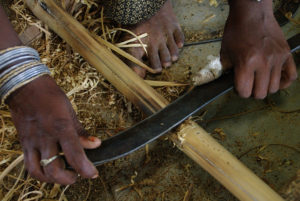Standing tall: Bamboo from restoration to economic development
- From
-
Published on
10.12.18
- Impact Area

Can grass be used to make tissues, furniture, pipes and even housing? Can it help to improve livelihoods and to mitigate climate change? Think beyond garden lawns and savannah landscapes, to bamboo.
“Bamboos, although they look like trees,” said the International Bamboo and Rattan Organisation’s (INBAR) Director General Hans Friederich in opening a recent side event at the Global Landscapes Forum (GLF) in Bonn, Germany, “are actually all grass species.” Bamboo provides a durable building material and strong fiber for paper and textiles without the need to fell trees. Additionally, Friederich explained that as a grass, bamboo grows back quickly after being harvested – making it a highly sustainable product to work with.
Photo credit: A woman whittles a piece of bamboo in India. Photo by International Bamboo and Rattan Organisation (INBAR)
Related news
-

Harnessing digital tools in securing soil health for Africa’s food future
Sehlule Muzata27.06.25-
Climate adaptation & mitigation
-
Environmental health
-
Nutrition, health & food security
-
Poverty reduction, livelihoods & jobs
Nairobi, 27 June 2025 (IITA) - As it marks its first anniversary, the Regional Hub…
Read more -
-

Harnessing digital tools in securing soil health for Africa’s food future
Sustainable Farming Science Program27.06.25-
Climate adaptation & mitigation
-
Environmental health
-
Food security
-
Poverty reduction, livelihoods & jobs
Nairobi, 27 June 2025 (IITA) - As it marks its first anniversary, the Regional Hub…
Read more -
-

Raising productivity and profits, How AgWise is Closing Yield Gaps through AI
Sehlule Muzata20.06.25-
Adaptation
-
Climate adaptation & mitigation
-
Environmental health
-
Food security
-
Poverty reduction, livelihoods & jobs
Nairobi, 20 June 2025 (IITA) - Across Africa smallholder farmers battle working with degraded soils,…
Read more -
